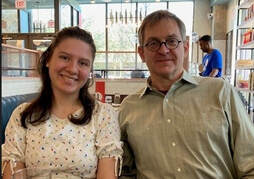THE NATIONAL GUILD OF ST. MARGARET OF SCOTLAND AWARD
The National Guild of St. Margaret of Scotland Award is given annually to a University of Chicago Medieval Studies student. The recipient is selected by the faculty and awarded to the student who has written the finest thesis in Medieval Studies. A monetary award and certificate is presented in May.
 Awardee Maia Driggers and her Advisor Tamara Golan
Awardee Maia Driggers and her Advisor Tamara Golan
THE GUILD'S 2023 AWARD RECIPIENT
Maia Driggers
Commendation for “Cinematic Reliquaries: Key Aspects of Physicality in The Passion of Joan of Arc (1928), The Trial of Joan of Arc (1962), and Joan of Arc at the Stake (1954)”
This is an ambitious and impressive study of cinematic medievalism, from which I learned a great deal. “Cinematic Reliquaries” argues that three twentieth-century films reimagine the saintly body of Joan of Arc in response to the trauma of Joan’s being burned at the stake—and, in the process, become devotional objects, “reliquaries,” in their own right.
Particularly remarkable is the author’s command of secondary scholarship not only on each of the three films analyzed but also on female sanctity in the Middle Ages, including visionary experience, embodiment, and virginity. “Cinematic Reliquaries” persuasively weaves together medieval studies and film studies, with the author’s own original cinematic analysis and historical contextualization binding the disparate threads together. This is an exemplary comparative study in so many ways: it establishes the longstanding (and ongoing) significance of its central figure, Joan of Arc; it delimits a sensible case study of three comparable films; it moves authoritatively between knowledge of the fifteenth century and of the twentieth; and it stages multiple occasions for comparison among the films and between medieval and modern, explaining the meaningful contrasts and connections in lucid prose. Were the author to expand and revise this work, I might encourage them to consider further the social role of film in the twentieth century and how that compares with religiosity in the later Middle Ages—a parallel that begins to come into focus in the final section, “Body of Saint, Body of Actress,” but that might have been explored earlier, in the essay’s introductory framework. This is not a criticism, but an indication of how suggestive and powerful many threads of the author’s argument are. The author should be congratulated on an exciting and accomplished piece of scholarship!
Maia Driggers
Commendation for “Cinematic Reliquaries: Key Aspects of Physicality in The Passion of Joan of Arc (1928), The Trial of Joan of Arc (1962), and Joan of Arc at the Stake (1954)”
This is an ambitious and impressive study of cinematic medievalism, from which I learned a great deal. “Cinematic Reliquaries” argues that three twentieth-century films reimagine the saintly body of Joan of Arc in response to the trauma of Joan’s being burned at the stake—and, in the process, become devotional objects, “reliquaries,” in their own right.
Particularly remarkable is the author’s command of secondary scholarship not only on each of the three films analyzed but also on female sanctity in the Middle Ages, including visionary experience, embodiment, and virginity. “Cinematic Reliquaries” persuasively weaves together medieval studies and film studies, with the author’s own original cinematic analysis and historical contextualization binding the disparate threads together. This is an exemplary comparative study in so many ways: it establishes the longstanding (and ongoing) significance of its central figure, Joan of Arc; it delimits a sensible case study of three comparable films; it moves authoritatively between knowledge of the fifteenth century and of the twentieth; and it stages multiple occasions for comparison among the films and between medieval and modern, explaining the meaningful contrasts and connections in lucid prose. Were the author to expand and revise this work, I might encourage them to consider further the social role of film in the twentieth century and how that compares with religiosity in the later Middle Ages—a parallel that begins to come into focus in the final section, “Body of Saint, Body of Actress,” but that might have been explored earlier, in the essay’s introductory framework. This is not a criticism, but an indication of how suggestive and powerful many threads of the author’s argument are. The author should be congratulated on an exciting and accomplished piece of scholarship!
 Awardee Natalie Nitsch and her Advisor Michael I. Allen
Awardee Natalie Nitsch and her Advisor Michael I. Allen
THE GUILD'S 2023 AWARD RECIPIENT
Natalie Nitsch
Commendation for “‘For whom this boke was made’: Evidence for a Lay Readership of Þe Myrrour of Simple Soulis”
This author has assembled an ambitious and meticulous archive of primary-source evidence, which the thesis contextualizes impressively in a complex (and partly obscure) set of medieval circumstances, to clarify its implications for the understanding of heresy in the later Middle Ages and the textual relations of monastics, clerics, and laity in England. The primary-source evidence is a set of 119 chapter headings, written on small tags of parchment and pasted into the margins of The Myrrour of Simple Soulis in the manuscript Bodley 505. (The Myrrour of Simple Soulis is a Middle English translation of a treatise by Marguerite Porete, which had been condemned as heretical.)
The author has prepared their own transcription of the tags directly from the manuscript, and the full text of these tags constitutes the appendix, where they are usefully juxtaposed with the chapter headings in an Anglo-Latin version of the Myrrour (drawn from a published edition). As the author argues on the basis of this evidence, the chapter tags in Bodley 505 do not correspond with any exactitude to the Anglo-Latin textual divisions. Instead, the author contends, they have a different function, namely, of preparing an exemplar that was to be copied as a lending text intended for lay readers. This appendix is already an impressive scholarly achievement, one that would be of immediate use to scholars of Middle English spiritual writing. However, the thesis does much more than this; it situates its archive of chapter tags within a rich matrix of historical circumstances, including the process by which Marguerite’s treatise was composed and condemned, the translation and circulation of her treatise (without attribution) in England, and the problematic twentieth-century historiography of medieval heresy. The result is a deeply informed and insightful study, which moves from fine-grained evidence to larger implications. Were the author to expand and revise this work, I might encourage them to consider the significance of the Wycliffite heresy in England, which altered the import of vernacular theology in English between the time of Archbishop Michael of Northbrook (d. 1361) and Richard Methley (d. 1527), particularly via Archbishop Arundel’s “constitutions” of 1407. Might that provide another avenue for thinking about medieval heresy, alongside the condemnation of Marguerite? My suggestion is not a criticism, but an indication of how suggestive and powerful many threads of the author’s argument are; I wanted to learn more!
The author should be congratulated on an exciting and accomplished piece of scholarship.
Natalie Nitsch
Commendation for “‘For whom this boke was made’: Evidence for a Lay Readership of Þe Myrrour of Simple Soulis”
This author has assembled an ambitious and meticulous archive of primary-source evidence, which the thesis contextualizes impressively in a complex (and partly obscure) set of medieval circumstances, to clarify its implications for the understanding of heresy in the later Middle Ages and the textual relations of monastics, clerics, and laity in England. The primary-source evidence is a set of 119 chapter headings, written on small tags of parchment and pasted into the margins of The Myrrour of Simple Soulis in the manuscript Bodley 505. (The Myrrour of Simple Soulis is a Middle English translation of a treatise by Marguerite Porete, which had been condemned as heretical.)
The author has prepared their own transcription of the tags directly from the manuscript, and the full text of these tags constitutes the appendix, where they are usefully juxtaposed with the chapter headings in an Anglo-Latin version of the Myrrour (drawn from a published edition). As the author argues on the basis of this evidence, the chapter tags in Bodley 505 do not correspond with any exactitude to the Anglo-Latin textual divisions. Instead, the author contends, they have a different function, namely, of preparing an exemplar that was to be copied as a lending text intended for lay readers. This appendix is already an impressive scholarly achievement, one that would be of immediate use to scholars of Middle English spiritual writing. However, the thesis does much more than this; it situates its archive of chapter tags within a rich matrix of historical circumstances, including the process by which Marguerite’s treatise was composed and condemned, the translation and circulation of her treatise (without attribution) in England, and the problematic twentieth-century historiography of medieval heresy. The result is a deeply informed and insightful study, which moves from fine-grained evidence to larger implications. Were the author to expand and revise this work, I might encourage them to consider the significance of the Wycliffite heresy in England, which altered the import of vernacular theology in English between the time of Archbishop Michael of Northbrook (d. 1361) and Richard Methley (d. 1527), particularly via Archbishop Arundel’s “constitutions” of 1407. Might that provide another avenue for thinking about medieval heresy, alongside the condemnation of Marguerite? My suggestion is not a criticism, but an indication of how suggestive and powerful many threads of the author’s argument are; I wanted to learn more!
The author should be congratulated on an exciting and accomplished piece of scholarship.
